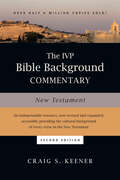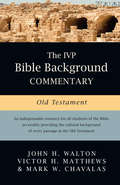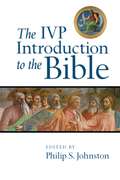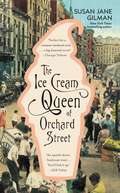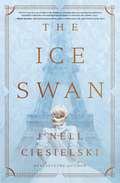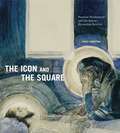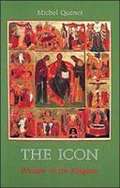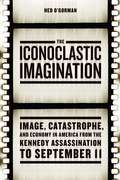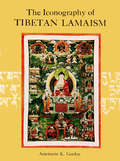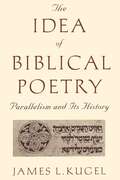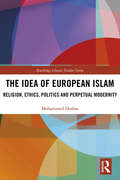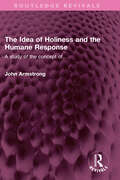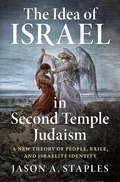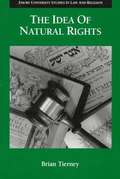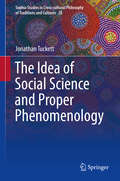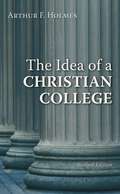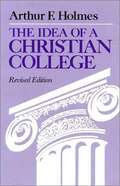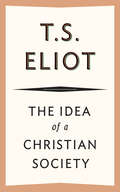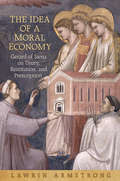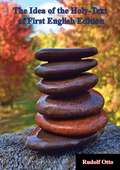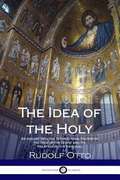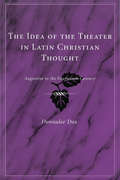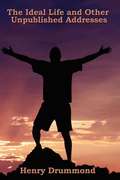- Table View
- List View
The IVP Bible Background Commentary: New Testament (Ivp Bible Background Commentary Set Ser.)
by Craig S. KeenerChristianity Today'sPreaching's
The IVP Bible Background Commentary: Old Testament (The\ivp Bible Background Commentary Ser.)
by Victor H. Matthews John H. Walton Mark W. ChavalasPreaching'sHow can we account for the "Book of the Law" suddenly being discovered during Josiah's renovation of the temple (2 Chron 34:14)?What might the psalmist have had in mind when praising God for removing our transgressions "as far as the east is from the west" (Ps 103:12)?What is meant by God "weighing the heart" (Prov 21:2)?The IVP Bible Background Commentary: New Testamenta glossary of historical terms, ancient peoples, texts and inscriptionsmaps and charts of important historical resourcesexpanded explanations of significant background issuesintroductory essays on each book of the Old TestamentThe IVP Bible Background Commentary: Old Testament
The IVP Introduction To The Bible
by Philip S. JohnstonThe Bible is a truly wonderful book. Millions of Christians through the ages and across the world have treasured it as their most valued possession, often insisting that anyone can pick up the Bible and read and understand it for themselves. But many of the details remain fuzzy until we find out more about their historical or literary setting.The IVP Introduction to the Bible is intended to reduce the fuzziness, in two ways: First, by providing background information to the whole Bible and each testament, as well as the gap between the testaments.Second, by introducing all the main sections of the Bible and each biblical book in turn.So the great biblical panorama is brought to life, first with broad brush strokes and then with fine art work.This Bible introduction is written by an international and interdenominational team of evangelical scholars, among them Desmond Alexander, author of From Paradise to the Promised LandTremper Longman III, author of How to Read the Psalms and How to Read ProverbsHoward Marshall, author of New Testament TheologyMark Strauss, author of Four Portraits, One JesusAll are involved in teaching biblical studies at a theological college, seminary or university, and each writing in their area of specialization. As they guide you expertly through the details, your understanding of the Bible and its message will be greatly enhanced. Readers of all stripes, from curious non-Christians to serious students of the Bible, will find The IVP Introduction to the Bible a helpful and enjoyable resource.
The Ice Cream Queen of Orchard Street: A Novel
by Susan Jane Gilman"An upside-down, funhouse treat. You'll lick it up." - USA TodayIn 1913, little Malka Treynovsky flees Russia with her family. Bedazzled by tales of gold and movie stardom, she tricks them into buying tickets for America. Yet no sooner do they land on the squalid Lower East Side of Manhattan when Malka is crippled and abandoned in the street.Taken in by an Italian ices peddler, she manages to survive through cunning and inventiveness. As she learns the secrets of his trade, she begins to shape her own destiny. She falls in love with a gorgeous, illiterate radical named Albert, and they set off across America in an ice cream truck. Slowly, she transforms herself into Lillian Dunkle, "The Ice Cream Queen" -- doyenne of an empire of ice cream franchises and a celebrated television personality. Yet Lillian Dunkle is nothing like the whimsical motherly persona she crafts for herself in the media. Conniving, profane, and irreverent, she is a supremely complex woman who prefers a good stiff drink to an ice cream cone. And when her past begins to catch up with her, everything she has spent her life building will be at stake.
The Ice Swan
by J'nell CiesielskiAmid the violent last days of the glittering Russian monarchy, a princess on the run finds her heart where she least expects it.1917, Petrograd. Fleeing the murderous flames of the Russian Revolution, Princess Svetlana Dalsky hopes to find safety in Paris with her mother and sister. But the city is buckling under the weight of the Great War, and the Bolsheviks will not rest until they have erased every Russian aristocrat from memory. Svetlana and her family are forced into hiding in Paris&’s underbelly, with little to their name but the jewels they sewed into their corsets before their terrifying escape.Born the second son of a Scottish duke, the only title Wynn MacCallan cares for is that of surgeon. Putting his talents with a scalpel to good use in the hospitals in Paris, Wynn pushes the boundaries of medical science to give his patients the best care possible. After treating Svetlana for a minor injury, he is pulled into a world of decaying imperial glitter. Intrigued by this mysterious, cold, and beautiful woman, Wynn follows Svetlana to an underground Russian club where drink, dance, and questionable dealings collide on bubbles of vodka.Out of money and options, Svetlana agrees to a marriage of convenience with the handsome and brilliant Wynn, who will protect her and pay off her family&’s debts. It&’s the right thing for a good man to do, but Wynn cannot help hoping the marriage will turn into one of true affection. When Wynn&’s life takes an unexpected turn, so does Svetlana&’s—and soon Paris becomes as dangerous as Petrograd. And as the Bolsheviks chase them to Scotland, Wynn and Svetlana begin to wonder if they will ever be able to outrun the love they are beginning to feel for one another.&“The Ice Swan is a ray of light in the middle of a Europe that was sinking into darkness. Ciesielski&’s talent for storytelling from the heart is a feast for the readers&’ eyes.&” —Mario Escobar, international bestselling author of Remember Me and Children of the StarsAdventurous World War I historical romanceFor fans of Kate Quinn, Beatriz Williams, and Aimie K. RunyanFull-length, stand-alone novel (approx. 120,000 words)Includes discussion questions for book clubs
The Icon and the Square: Russian Modernism and the Russo-Byzantine Revival
by Maria TaroutinaIn The Icon and the Square, Maria Taroutina examines how the traditional interests of institutions such as the crown, the church, and the Imperial Academy of Arts temporarily aligned with the radical, leftist, and revolutionary avant-garde at the turn of the twentieth century through a shared interest in the Byzantine past, offering a counternarrative to prevailing notions of Russian modernism. Focusing on the works of four different artists—Mikhail Vrubel, Vasily Kandinsky, Kazimir Malevich, and Vladimir Tatlin—Taroutina shows how engagement with medieval pictorial traditions drove each artist to transform his own practice, pushing beyond the established boundaries of his respective artistic and intellectual milieu. She also contextualizes and complements her study of the work of these artists with an examination of the activities of a number of important cultural associations and institutions over the course of several decades. As a result, The Icon and the Square gives a more complete picture of Russian modernism: one that attends to the dialogue between generations of artists, curators, collectors, critics, and theorists.The Icon and the Square retrieves a neglected but vital history that was deliberately suppressed by the atheist Soviet regime and subsequently ignored in favor of the secular formalism of mainstream modernist criticism. Taroutina’s timely study, which coincides with the centennial reassessments of Russian and Soviet modernism, is sure to invigorate conversation among scholars of art history, modernism, and Russian culture.
The Icon and the Square: Russian Modernism and the Russo-Byzantine Revival
by Maria TaroutinaIn The Icon and the Square, Maria Taroutina examines how the traditional interests of institutions such as the crown, the church, and the Imperial Academy of Arts temporarily aligned with the radical, leftist, and revolutionary avant-garde at the turn of the twentieth century through a shared interest in the Byzantine past, offering a counternarrative to prevailing notions of Russian modernism. Focusing on the works of four different artists—Mikhail Vrubel, Vasily Kandinsky, Kazimir Malevich, and Vladimir Tatlin—Taroutina shows how engagement with medieval pictorial traditions drove each artist to transform his own practice, pushing beyond the established boundaries of his respective artistic and intellectual milieu. She also contextualizes and complements her study of the work of these artists with an examination of the activities of a number of important cultural associations and institutions over the course of several decades. As a result, The Icon and the Square gives a more complete picture of Russian modernism: one that attends to the dialogue between generations of artists, curators, collectors, critics, and theorists.The Icon and the Square retrieves a neglected but vital history that was deliberately suppressed by the atheist Soviet regime and subsequently ignored in favor of the secular formalism of mainstream modernist criticism. Taroutina’s timely study, which coincides with the centennial reassessments of Russian and Soviet modernism, is sure to invigorate conversation among scholars of art history, modernism, and Russian culture.
The Icon: Window on the Kingdom
by Michel QuenotTo understand the icon, one must comprehend its organic unity: artistic, spiritual, theological. Quenot's analysis of various icons and their theological elements enables the readers to appreciate the various aspects of the icon more fully. There are currently many books written about icons, discussing either their historical context, describing their spiritual attraction, or simply showing their aesthetic beauty. The Icon is, however, an exceptional book in many ways.
The Iconoclastic Imagination: Image, Catastrophe, and Economy in America from the Kennedy Assassination to September 11
by Ned O'GormanBloody, fiery spectacles--the Challenger disaster, 9/11, JFK's assassination--have given us moments of catastrophe that make it easy to answer the "where were you when" question and shape our ways of seeing what came before and after. Why are these spectacles so packed with meaning? In The Iconoclastic Imagination, Ned O'Gorman approaches each of these moments as an image of icon-destruction that give us distinct ways to imagine social existence in American life. He argues that the Cold War gave rise to crises in political, aesthetic, and political-aesthetic representations. Locating all of these crises within a "neoliberal imaginary," O'Gorman explains that since the Kennedy assassination, the most powerful way to see "America" has been in the destruction of representative American symbols or icons. This, in turn, has profound implications for a neoliberal economy, social philosophy, and public policy. Richly interwoven with philosophical, theological, and rhetorical traditions, the book offers a new foundation for a complex and innovative approach to studying Cold War America, political theory, and visual culture.
The Iconography of Tibetan Lamaism
by Antoinnette K. GordonThe Iconography of Tibetan Lamaism was first published twenty years ago for the express purpose of "giving the student interested in Tibetan iconography a general idea of the development of Buddhism into Lamaism, and making easier the identification of the various deities of the Tibetan pantheon." Although interest in the field has grown over the years, the book has remained the only authoritative work of its kind. Long out of print and rare even in the second-hand bookshops it is now being offered in a new, revised and enlarged edition to meet the persistent and increasing demand for it.This book gives a descriptive outline of the principal gods in the Tibetan pantheon, tracing the main features and symbols that are used to denote each one. A Comprehensive illustrated list of the various ritual objects, talismans, symbols, mudras (symbolic hand poses), and asanas and vahanas (position of the lower limbs) that are used in the images of the gods is accompanied with a word list of the Sanskrit terms most commonly encountered in a study of Lamaism.A set of thirty-one thang-kas from the famous collection of Baron A. von Stael-Holstein, formerly of Peking, China, which came to America after the publication of the original edition of the book, has been included in this new and revised edition.
The Idea of Biblical Poetry: Parallelism and Its History
by Prof James KugelIs there poetry in the Bible? Does it have rhyme or meter? How did ancient Hebrew writers compose their works? James Kugel's provocative study provides surprising new answers to these age-old questions. Biblical "poetry" is not a concept native to the Bible itself, he proposes, and the idea that the Bible is divided into prose and verse is merely an approximation of the reality of biblical style. Arguing that the Bible presents a continuum of speech heightened in varying degrees by different means, Kugel sets out to describe Hebrew's high style on its own terms. He also offers a thorough history of the idea of biblical poetry, starting with Philo of Alexandria and Josephus in the first century C.E. and charting its development through the Church Fathers, medieval Jewish writers, the Christian Hebraists of the Renaissance, and on into modern times. The story of how each age understood the nature biblical poetry, Kugel concludes, is a key to understanding the Bible's place in the history of Western thought.
The Idea of European Islam: Religion, Ethics, Politics and Perpetual Modernity (Routledge Islamic Studies Series)
by Mohammed HashasSuspicions about the integration of Islam into European cultures have been steadily on the rise, and dramatically so since 9/11. One reason lies in the visibility of anti-Western Islamic discourses of salafi origin, which have monopolized the debate on the "true" Islam, not only among Muslims but also in the eyes of the general population across Europe; these discourses combined with Islamophobic discourses reinforce the so-called incompatibility between the West and Islam. This book breaks away from this clash between Islam and the West, by arguing that European Islam is possible. It analyzes the contribution that European Islam has made to the formation of an innovative Islamic theology that is deeply ethicist and modern, and it clarifies how this constructed European Islamic theology is able to contribute to the various debates that are related to secular-liberal democracies of Western Europe. Part I introduces four major projects that defend the idea of European Islam from different disciplines and perspectives: politics, political theology, jurisprudence and philosophy. Part II uses the frameworks from three major philosophers and scholars to approach the idea of European Islam in the context of secular-liberal societies: British scholar George Hourani, Moroccan philosopher Taha Abderrahmane and the American philosopher John Rawls. The book shows that the ongoing efforts of European Muslim thinkers to revisit the concept of citizenship and political community can be seen as a new kind of political theology, in opposition to radical forms of Islamic thinking in some Muslim-majority countries. Opening a new path for examining Islamic thought "in and of" Europe, this book will appeal to students and scholars of Islamic Studies, Islam in the West and Political Theology.
The Idea of Holiness and the Humane Response: A study of the concept of... (Routledge Revivals)
by John ArmstrongFirst Published in 1981, The Idea of Holiness and the Humane Response is a radically innovative book, presenting a critical appraisal of the concept of holiness and its effects. It offers a view of holiness far less favourable than the traditional one, yet its conclusions are by no means purely critical or negative. For it sees certain other elements in Hebrew thought as marvelously rich and fertile, insistently reasserting themselves, but repeatedly overwhelmed by an opposed and stronger passion for the idea of holiness. This book is an interesting read for scholars of religion, social history and psychology.
The Idea of Israel in Second Temple Judaism: A New Theory of People, Exile, and Israelite Identity
by Jason A. StaplesIn this book, Jason Staples proposes a new paradigm regarding the biblical concept of Israel and how it was shaped by Jewish apocalyptic hopes for restoration after the Babylonian Exile. Challenging conventional assumptions about Israelite identity in antiquity, his argument is based on a close analysis of a vast corpus of biblical and other early Jewish literature and material evidence. Staples demonstrates that continued aspirations for Israel's restoration in the context of diaspora and imperial domination remained central to Jewish conceptions of Israelite identity throughout the final centuries before Christianity and even into the early part of the Common Era. He also shows that Israelite identity was more diverse in antiquity than is typically appreciated in modern scholarship. His book lays the groundwork for a better understanding of the so-called 'parting of the ways' between Judaism and Christianity and how earliest Christianity itself grew out of hopes for Israel's restoration.
The Idea of Natural Rights: Studies on Natural Rights, Natural Law and Church Law, 1150-1625
by Brian Tierney. " . . a compelling historical account of natural rights. . . . That Tierney brings to his historical task a thorough acquaintance with major contemporary theories of moral and legal rights gives his work additional value for ethicists. " - Religious Studies Review . " . . a tour de force of integration and learning. . . . It is a synthesis that will become the required starting point in all future efforts to write about the history of rights. " - Studia canonica This series, originally published by Scholars Press and now available from Eerdmans, is intended to foster exploration of the religious dimensions of law, the legal dimensions of religion, and the interaction of legal and religious ideas, institutions, and methods. Written by leading scholars of law, political science, and related fields, these volumes will help meet the growing demand for literature in the burgeoning interdisciplinary study of law and religion.
The Idea of Social Science and Proper Phenomenology (Sophia Studies in Cross-cultural Philosophy of Traditions and Cultures #28)
by Jonathan TuckettThis monograph examines an academic discipline in crisis. The author claims that this field concerned with society and relationships is in trouble. No one can seem to agree on what it does or how to go about doing it. His insightful argument revives the thought of key phenomenologists often no longer considered in social science. Looking predominantly at debates within religious studies, this book uncovers certain misguided presuppositions which have strongly influenced scholars in the field. This reflects itself in a Weberian Ideal regarding the institutional place of science in the universities and a failure to properly consider the epistemic status of knowledge produced for its own sake. But even recognizing these issues will not get to the core of the crisis. It will not help scholars better understand what it is to be human. To address this, the author digs deeper. He draws on the philosophical phenomenology of Husserl’s Phenomenological Movement to critique our very idea of social science. In the process, he presents a radical approach to the question of humanity. This volume concludes that, properly understood, social science is a hobby. It deserves no special place in the university. Indeed, if it is to be pursued properly, it requires a fundamentally revised understanding of humanity. The author argues this not of the sake of controversy. Rather, his intention is to affect the necessary shift in our understanding that will enable future constructive solutions.
The Idea of a Christian College
by Arthur F. HolmesThis revised edition of a classic text provides a concise case for the role of the Christian college and its distinctive mission and contribution. Holmes has extensively revised several chapters and included two new chapters: "Liberal Arts as Career Preparation" and "The Marks of an Educated Person."
The Idea of a Christian College (Revised Edition)
by Arthur F. HolmesThis revised edition of a classic text provides a concise case for the role of the Christian college and its distinctive mission and contribution. Holmes has extensively revised several chapters and included two new chapters: "Liberal Arts as Career Preparation" and "The Marks of an Educated Person.
The Idea of a Christian Society
by T. S. EliotOne of the twentieth century&’s great thinkers and writers explores what it means to incorporate Christian values into our worldly lives. Originally delivered in 1939 at Corpus Christi College, these three lectures by the renowned poet and playwright T. S. Eliot address the direction of religious thought toward criticism of political and economic systems. With sincerity and intellectual rigor, the Nobel Prize winner asks whether—and how—it is possible for Christianity to coexist with Western democracy and capitalism.
The Idea of a Moral Economy: Gerard of Siena on Usury, Restitution, and Prescription
by Lawrin ArmstrongThe Idea of a Moral Economy is the first modern edition and English translation of three questions disputed at the University of Paris in 1330 by the theologian Gerard of Siena. The questions represent the most influential late medieval formulation of the natural law argument against usury and the illicit acquisition of property. Together they offer a particularly clear example of scholastic ideas about the nature and purpose of economic activity and the medieval concept of a moral economy.In his introduction, editor Lawrin Armstrong discusses Gerard's arguments and considers their significance both within the context of scholastic philosophy and law and as a critique of contemporary mainstream economics. His analysis demonstrates how Gerard's work is not only a valuable source for understanding economic thought in pre-modern Europe, but also a fertile resource for scholars of law, economics, and philosophy in medieval Europe and beyond.
The Idea of the Holy-Text of First English Edition
by Rudolf OttoOtto's most famous work is The Idea of the Holy, published first in German in 1917, and first translated into English in 1923. It is one of the most successful German theological books of the 20th century, has never gone out of print, and is now available in about 20 languages. The book defines the concept of the holy as that which is numinous. Otto explained the numinous as a "non-rational, non-sensory experience or feeling whose primary and immediate object is outside the self".-Print ed.
The Idea of the Holy: An Inquiry into the Non-Rational Factor in the Idea of the Divine and Its Relation to the Rational
by John Harvey Rudolf OttoRudolf Otto's classic The Idea of the Holy brims with deep theological and philosophical insights into the theory of religion and spiritual belief in God. As both a theologian and a philosopher, Otto was fascinated by how the rational and non-rational interact and interplay with regard to humanity's religious beliefs. This investigation determines that valid, non-rational experiences are as poignant in the development of knowledge - yet how do we quantify and apportion value to various rational arguments for faith, and the experiences so many believers have had over the millennia? <p> The author delves into these arguments, and valiantly attempts to determine how the divine interacts with various emotions. He coins the term 'numinous' from the root word 'numen', to denote an emotional state of consciousness apt to receive spiritual insight. The many emotions and attuning of the soul to God falls under the designation, and it proved to be one of the most important ideas Otto would ever advance. <p> The Idea of the Holy remains an important text for students of both philosophy and religion, as well as spiritually inclined readers. Although Christian believers will profit from its concepts and deep discussion of spiritual matters, those of a different faith or of none often come to respect the intricacy and depth with which Otto explains and qualifies his theology in rational and non-rational terms. This edition contains the text of the original first translation to English of 1923 by John W. Harvey, who strived to preserve the clarity, concision and poise of Otto's lessons. Since the book was originally published in German in 1918, it has been translated into over twenty different languages.
The Idea of the Muslim World: A Global Intellectual History
by Cemil AydinAs Cemil Aydin explains in this provocative history, it is a misconception to think that the world’s 1.5 billion Muslims constitute a single religio-political entity. How did this mistaken belief arise, why is it so widespread, and how can its grip be loosened so that a more fruitful discussion about politics in Muslim societies can begin?
The Idea of the Theater in Latin Christian Thought: Augustine to the Fourteenth Century
by Donnalee DoxMedieval thinkers did not construe drama as theatrical performances, Dox (performance studies, Texas A&M U. ) argues, because of how thought was organized beginning with the late classical transmitters and through the Scholastics. Theater as a performance practice and institutional institution was distinguished from poetry, rhetoric, reading, and writing until the height of the Scholastic period, early in the 14th century, when this categorical distinction began to break down. She says her conclusions complement rather than challenge others derived from the same material. Annotation ©2004 Book News, Inc. , Portland, OR (booknews. com)
The Ideal Life and Other Unpublished Addresses
by Henry DrummondThe addresses which make up this volume were written by Professor Drummond between the years 1876 and 1881, and are now published in the hope that they may continue his work. Included here are "Ill-Temper," "Why Christ Must Depart," "Going to the Father," "The Eccentricity of Religion," "To Me to Live Is Christ," "Clairvoyance," "The Three Facts of Sin," "The Three Facts of Salvation," "Marvel Not," "Penitence," "The Man After God's Own Heart," "What is Your Life?," "What is God's Will?," "The Relation of the Will of God to Sanctification," and "How to Know the Will of God."
